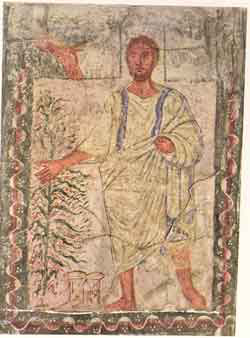Introduction
Why are there so many women in the Book of Judges? With Susan Ackerman (Warrior, Dancer, Seductress, Queen: Women in Judges and Biblical Israel, 1998), we count 12 individuals, as well as three groups: Achsa, the daughter of Caleb and wife of Othniel (Judges 1); Deborah the Prophetess, Yael the Kenite and the mother of the Canaanite general Sisera, along with the wisest of her ladies (Judges 4 – 5); the woman of Tebetz who kills Abimelech (Judges 9); Jephthah’s daughter and her companions (Judges 11); Manoah’s wife ( a.k.a Samson’s mother), Samson’s first wife, the harlot in Gaza and Delilah (Judges 13 – 15); the mother of Micah (Judges 17); and finally the Levite’s concubine and the women of Benjamin (Judges 19 – 21). This cast of female characters is clearly unlike that of Genesis, Exodus and Ruth, whose women are involved mainly in the continuity of the people of Israel. Some of Judges’ women are non-Israelites; most are not mothers.
Ackerman delineates 6 types of women in Judges: the military hero, the cult specialist, the queen mother, the housewife-mother, the seductress and the wife. Raphael Patai, in his book The Hebrew Goddess, designates 4 aspects of the matronita, “the goddess of the Kabbala”: the virgin, the mother, the warrior and the harlot. Carl Jung coined the term “anima” to designate the feminine side of the human psyche. He noted that this inner component is reflected in different characterizations of women in myth and legend: the femme fatale, the earth mother, the love goddess, the virgin and the apotheosis of Wisdom. All of these are attempts to classify the images of “Woman” in literature and imagination. Here, we will attempt to determine how relevant these categories are for the Book of Judges and to show the transformation of the reading of these women from the Bible, to Midrash, to the visual Midrash of Art.
Our thesis is that unlike the women of Genesis, Exodus and Ruth who build up Israel, the women of Judges embody the breakdown of Israelite society, after the death of Joshua and before the founding of the Israelite kingship. The phrase “in those days there was no king in Israel; each man did whatever was right in his own eyes (whatever he pleased)” is repeated four times in the book of Judges. This repetition expresses the Book of Judges editor's view of the period as chaotic and anarchic. The position of women in biblical Israel, as is well know, was inferior in the best of times; in such a period, it became tenuous and even endangered. Unexpectedly, women sometimes took charge in the absence of male responsibility.
As in most of the Bible, the women of Judges are often nameless, identified only by their relationships to men. Few biblical women are provided with physical or personality markers; none in the book of Judges. Affect is, as usual, submerged in the biblical narrative. Artists therefore are forced to flesh out these mannequins, give them personality and read their relationships.
In sum, the narrative of the women of Judges builds to a crescendo, from the seemingly passive Achsah and climaxes in the brutal rape and dismemberment of the Levite’s nameless concubine. A bittersweet note ends the book with a group of dancing women abducted for wives of the decimated tribe of Benjamin, in order to continue their line. The theme of anarchy, however, echoes as the book’s parting shot.
Achsah
Who is Achsah in the Bible, who is she in art and who is she in Midrash?
In Judges 1:11-15, Achsah takes the stage as the prize to be given by her father Caleb to the warrior who will lead the conquest of Kiryat Sefer.
Othniel, Caleb’s younger brother, leaps to the military challenge by taking the city and gets the bride. But contrary to our initial impression, Achsah turns out to be a resourceful and assertive character; she pushes her husband to ask for a dowry of land and then takes the initiative to obtain the vital water source.
The two illustrations below read the relationship between the two men and the woman.
In the Byzantine Smyrna Octateuch, Achsah, central to the negotiation, stands in front of her passive husband and conducts business, while her father presides.
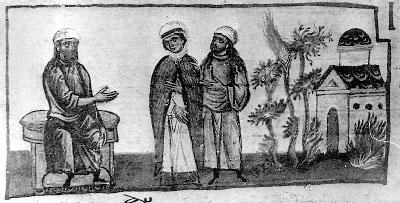
Caleb, her father, extending his hand, grants her something, which becomes clear in the picture below.
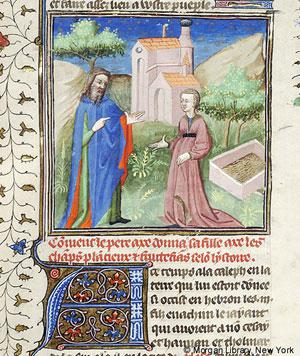
In this picture, Othniel the husband is not even present, leaving Achsah to bargain on her own. Behind her can be seen a pool of water: these are the upper and lower water sources necessary to cultivate the Negev land.
The passage in Judges 1, regarding the perks of warfare, is transformed in a Talmudic Midrash. Midrash never loses an opportunity to transform the most unlikely secular reference into an aspect of Torah. Here the Midrash centers on the name Kiryat Sepher (lit., the City of the Book), which Othniel conquers. The book becomes the Torah, Othniel becomes a Torah scholar and Achsah is the businesswoman, who manages family affairs, so her husband can learn. As always, Art and Midrash read the Bible as if they are looking into a mirror of their own time.
Deborah
Our story opens, in accordance with the pattern of the book of Judges, with a military crisis; Israel has been oppressed for twenty years by Yabin king of Hazor and his chief of staff Sisera and their formidable chariot army. The curtain rises on Deborah, without any exposition: no one calls her, the hand of God does not rest on her, she’s simply there, sitting beneath her palm tree, a prophetess judging Israelites, in the district between Bethel and Ephraim, in her outdoor courthouse. But we already know that the Judges of this book are mainly military, not judicial leaders and certainly not women. A dialogue ensues concerning the enemy. Deborah appoints Barak and gives him a battle plan. Surprisingly, Barak agrees, “but only if you go with me”, to which Deborah replies: “not you, but a woman will get the glory”.
From atop Mt. Tabor, Deborah gives the signal for the battle to begin. From this point, we hear no more of Deborah until the next chapter, in which she sings a song of praise to God in honor of the great victory over Yabin, Sisera and their forces. This episode ends abruptly with a notice of 40 years of peace, but without further reference to Deborah. So little information is forthcoming about the nature of her mission, that Midrash and art are free to fill in the lacunae.
Three types of Jewish commentary relate to Deborah’s role and activities: 1st century CE Hellenistic paraphrases of the Bible, rabbinic aggada of the 6th to 10th centuries and medieval rationalist commentary (13th century). The Hellenistic writers (Josephus and Pseudo-Philo) see Deborah as a prophetic preacher, who inspires the secular war leader, Barak. The rabbinic Midrashim understand the job description of judge and prophet as one who teaches Torah and dispenses justice (presiding outdoors, in order to avoid the rabbinic prohibition on a woman being alone with a man). She even manages to upgrade the status of her unschooled husband by teaching him to makes wicks for the Temple lamps. Finally, R. Levi ben Gershom (on Judges 4:4) portrays Deborah as a fiery prophetic sermonizer, calling the people to repentance. In sum, the lack of detail in the biblical account allows each age to reinvent Deborah in its own image.
Similarly in art. For example, transforming the biblical description of Deborah’s judicial role, this 15th century illuminated manuscript illustrates a Court scene in full regalia, with Deborah in the role of the queen.
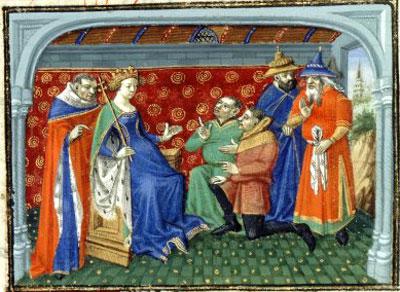
Behind her stands a priest (Barak?), not so subtly coaching her, and before her kneel two bare-headed suppliants behind whom stand two figures identified by their Jews’ hats. If we didn’t know (from the accompanying text) that this is supposed to be Deborah, we would probably identify it as a 15th century European court
The queen of the 15th century morphs in the 19th and 20th centuries. We find completely different readings of the same biblical account.
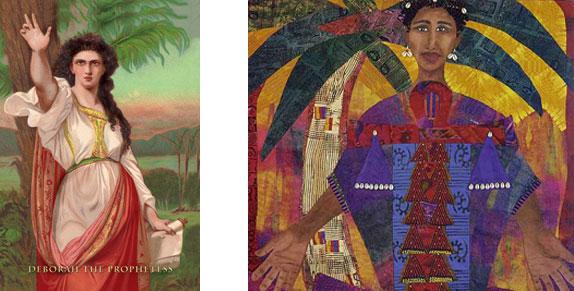
From Harriet Beecher Stowe's Adrien Cruz,
1874
An unknown 19th century American artist pictured Deborah under her palm tree, in accordance with the biblical text. She is dressed in classical Greek or Roman garb, holds a scroll in one hand and gestures dramatically with the other, while standing in front of Lake Kinneret (or is it Lake Tahoe?). This is the White version
Adrien Cruz, a Harlem-born artist, pictures a statuesque Deborah clothed in vivid fabric decorated with shells and standing beneath a luxuriant palm, seemingly somewhere in the Caribbean or Africa. Cruz imagines the ancient prophetess Deborah in terms of her own background and agenda: an imposing, beautiful Black woman, a kind of queen-priestess. In fact, the mention of the palm tree in Judges 4 is probably to be associated with worship and oracular communication with/by the divine presence.
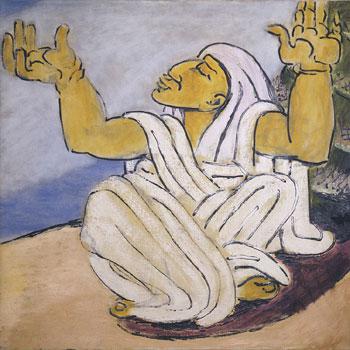
Ben-Zion (Weinman), Deborah the Prophetess
Expressionist artist Ben-Zion sees Deborah, her eyes closed in ecstatic song and prayer.
An earthy, muscular figure, wrapped in Levantine stripes, she sits low on a mat; strength pervades her upturned face and powerful arms. It feels like a huge voice would come out of this body. The style of Ben-Zion expresses the post-holocaust yearning for a “new Hebrew man” (and woman), different from the pale, passive shtetl stereotype.
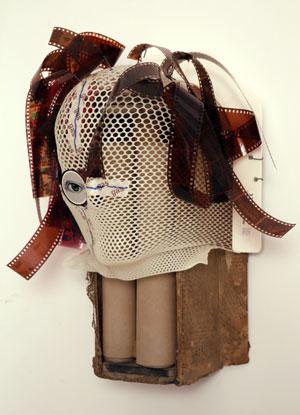
Jo Milgrom, Deborah’s Eye
prophetess
wildly coiffed
masked for privacy
she holds court
in public
en masse they climb
seeking that eye
her judgment
beneath the palm tree
a Biblical heroine
heralded by an
unheralding culture
she chooses the general
to lead the army
she leads
her vision
vanquishes
the chariots of Sisera
Deborah’s job description is expanded "midrashically", in the battle scenes below. Our text says she accompanied Barak, in planning the strategy of the imminent battle with the Canaanites. But in the Bible, women are never seen actually riding into the fray. Despite this, two 13th century depiction of the battle show Deborah on horseback. In the Saint Louis Psalter below, Deborah rides sidesaddle with Barak, directing the charge; all eyes are upon her.
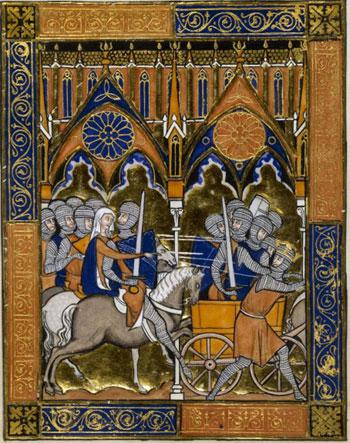
Even more assertive is the colorful scene in the Morgan Bible. Pushing out of the picture frame, Deborah, astride her own horse, leads her forces, trampling the enemy. We recall the passage “the honor will not be yours; for the Lord will hand Sisera over to a woman”.
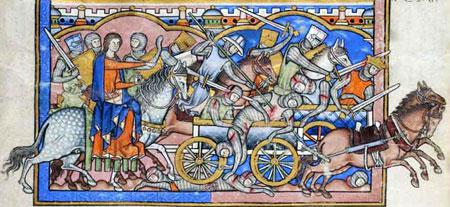
But nowhere in the biblical text does it say that Deborah actually rode into battle. What then is the basis for these two French 13th century renditions? It is entirely possible that Eleanor of Aquitaine was the model for these Deborahs. Eleanor was one of the most powerful women in Europe at the end of the 12th century, Queen of France and England; she accompanied her first husband, Louis VII of France on the Second Crusade and spearheaded her son Henry III’s revolt against her second husband, Henry II of England. In a fresco from the chapel of Sainte Radegonde in Chinon antedating our two manuscripts, Eleanor rides her own mount, in a pose strikingly similar to the two renditions of Deborah.
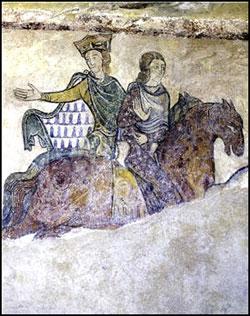
"Contemporary" historical/political figures can become the model for picturing the spare characters of the Bible. Thus history creates visual midrash.
Yael
Our story continues. Earlier, we read that the Lord would hand Sisera over to a woman. Which woman? The battle ends with Sisera fleeing on foot; he finds refuge with Yael, a member of the supposedly friendly Kenite clan. In both prose and poetic accounts, Yael’s hospitality is replete with sexual inuendos: coming out to meet him, inviting him into her tent (contrasting with Deborah, whose judges in the open air), feeding and covering him. These suggestive verbs are amplified in the poem of chapter 5: falling between her legs no less than seven times. Yael hammers a tent peg through Sisera’s temple, bringing the curtain down on this drama.
Midrash relishes the sexual undertones, justifying Yael’s actions. Pseudo-Philo heightens the sexual tension, embellishing Yael’s appearance and scattering rose petals on the bed. Sisera would like to marry her, with his mother’s approval, and his thirst is because of his “burning soul”. This suggestive scene sometimes stimulated the artistic imagination.
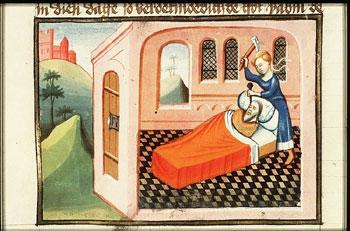
This most proper 15th century Flemish illuminated manuscript opens Yael’s house to our view of the master bedroom, where Sisera is primly tucked into bed. The efficient housewife, Yael is about to nail Sisera, between one chore and the next.
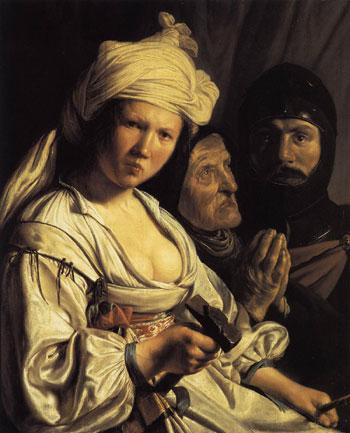
Salomon de Bray is the “photographer” who poses the three heroes of the story for posterity: Yael in the foreground - sexy, tough, unflinching and without regret – defiantly displays her weapons; the elderly Deborah assumes a pious pose and Barak, the simple soldier, remains partially in the shadows of the two heroic women.
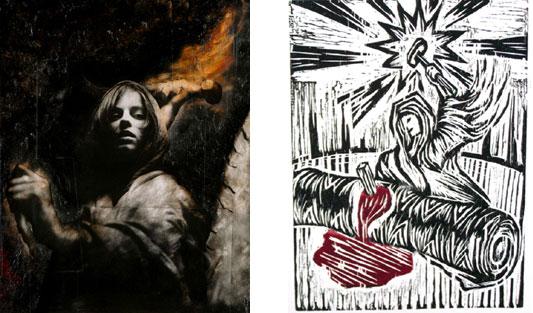
In Kevin Rolly’s photomontage, seen from the victim’s angle, Yael descends upon her prey. She is a cold-blooded killer. Using a different medium, Matt Burger’s woodcut retells the story with Yael luring Sisera into a trap. Rolled in a rug to hide him from his Israelite pursuers, he is an convenient mark for the coup de grace. The model of both these contemporary renditions of Yael’s deed is the psychological thriller.
The movement from Gothic to Baroque to Modern Art shows the midrashic sensitivities of each period.
Sisera’s mother
Yet another woman is introduced in the song of Deborah: Sisera’s mother, who Deborah portrays as waiting anxiously and expectantly for her son’s return with the spoils of battle. We might think that she is treated sympathetically here, but the use of a widespread ancient Near Eastern motif reveals an entirely different attitude.
Through the window peered Sisera's mother;
behind the lattice she sobbed
Why is his chariot so long in coming?
Why tarry the hoofbeats of his chariots?’
The motif of the woman at the window usually refers to a prostitute, soliciting her clients, as in an ivory from the palace of 8th century BCE Assyrian king Assurnasirpal II. Thus the actual intention of the biblical account is as a cruel parody.
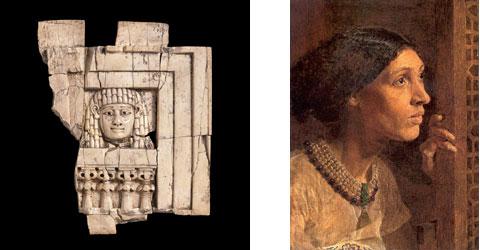
In contrast, British artist A.J. Moore portrays Sisera’s mother sympathetically, every soldier’s mother, standing by the window and dreading bad news. A contemporary mother might be holding a cell phone, expecting a call from Iraq.
We return to our starting point in order to summarize the adventures of Deborah through the detailed work of Nahum Halevi, pseudonym of Dr. Nathan Moskowitz. This contemporary Jewish American artist fuses all the above elements of Deborah’s resume.

Crowned with a palm tree, she also rides into battle, one hand wielding a sword. On her right and below are the troops of Israel, bearing their tribal insignia from Jacob’s blessing in Genesis 49: Barak and his tribesman are crowned with the horns of Naphtali, Zebulon’s representative wears a boat-hat, Joseph’s warrior is crowned with a vine, Benjamin is a wolf and Issachar is a donkey. The tribes terminate in a bright turquoise wedge, in which the Canaanite forces are drowning in the Kishon River.
Above the river, diminutive Yael, still wields her hammer, sitting astride Sisera who lies prone, his knife falling from his hand. The tent is a beautiful patchwork and comely, made-up Yael is dressed to kill.
Finally, returning to Deborah, we see that her left hand holds aloft the scales of justice, modeled after the Latin goddess Justicia.
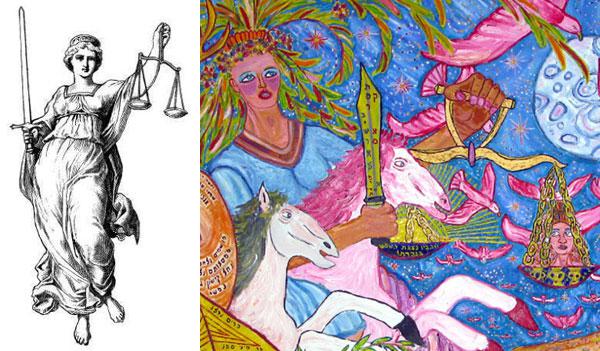
These scales are central to the painting; one pan holds the victorious sun and is inscribed with the verse from the song of Deborah:
your faithful ones are as the rising sun.
In this same verse, the faithful are weighed against God’s enemies; we expect therefore a representative of these enemies in the other pan but observe a woman’s head. This is Sisera’s mother (who has appeared in the preceding verses of Judges 5), framed by the chains of the scale, which reflect the braids of the “woman in the window” ivory, just as the pan is decorated with the same palm-tree balustrade.
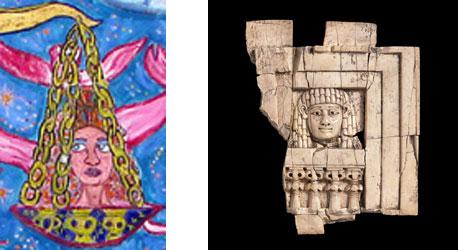
In this second episode of Judges, three diverse female personalities emerge, upstaging the male figures: the prophetess, the femme fatale and the grieving mother. Other women, other crises will emerge from the chaos of the following chapters of Judges.
Samson’s women: Manoah’s Wife
Samson, the Bible’s Superman, is not the focus of this essay; rather it is the constellation of women who revolve around him. The first woman on the stage is his mom, another nameless woman, known in the Bible only as the wife of Manoah. We meet her receiving the annunciation of Samson’s birth, from an angel who she thinks is merely a “man of God”. Since we’ve already been told that she is barren, this is a tremendous surprise. Manoah, who missed the annunciation, asks God for a replay, which is granted. Again he is absent, but Mrs. Manoah runs to get him when the stranger appears. Manoah asks about the future of his son, to which the angel replies only regarding the restrictions of Mrs. Manoah’s pregnancy. Manoah then invites the “man of God” to stay for dinner, but is met with an enigmatic decline. When an offering is placed on the altar, the “man” suddenly disappears heavenward. Only then does the couple realize that the “man” was an angel – Mrs. Manoah calms her husband’s terror at this close encounter. From the above description, it is clear that Manoah is nothing more than a clueless foil and his wife is the dominant mover. The link between the three characters is stressed audibly in the Hebrew text by the repeated use of the term ish, man: isha, woman, wife; ishah, her husband and ish haelohim, a man of God. An audience listening to the story would be hearing sh…sh…sh. The tangle between the three has an auditory component.
The artwork that we have on this scene mainly focuses on the relationship between Manoah and his wife, complicated by the arrival of the ish.
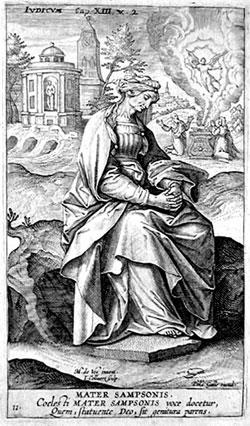
This engraving from a 17th century book on biblical women, presents a magisterial figure of Mrs. Manoah, large and central, serene and expectant. In the upper right background, we see the explosive revelation of the angel
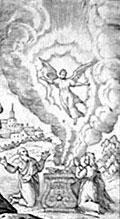
– kneeling on either side of the altar, Manoah raises his hands in terror, while his wife clasps her hands calmly in gratitude.
An earlier Dutch version reverses the responses.
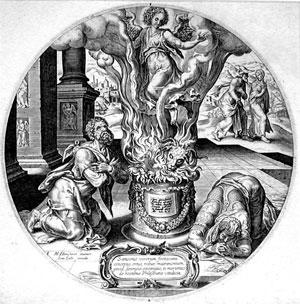
Here, Manoah crosses his hands in prayer as he looks up at the ascending angel; simultaneously, his wife buries her head in the ground, fearing the dangerous sight, in complete contradiction to the biblical text.
Finally, Rembrandt’s drawing is wild with excitement. The angel lifts off the launching pad of the sacrifice. Manoah on his knees recoils in fear, while his wife stands behind him, gesturing to protect him from his unwarranted panic.
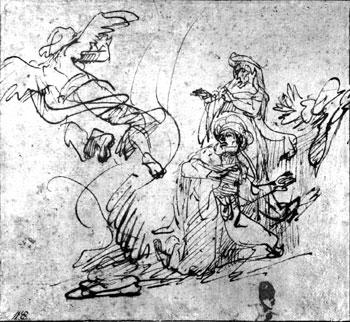
In a later oil, Rembrandt depicts a devout, intimate couple, both clasping their hands in gratitude. The turmoil of the drawing is absent in the warm, rich shades of the oil.
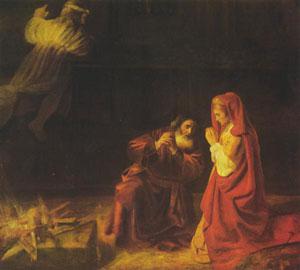
Thus, the artists deal in a variety of manners with the biblical dominance of Mrs. Manoah, some of them following the original intention and some reversing the couple’s relationship. Similarly, following a general pattern, the major Midrash (Bamidbar Rabbah 10:5) on this scene highlights Manoah and makes his wife into a secondary, albeit righteous, character.
Delilah
Although several more women appear in the continuation of the Samson stories, we will now fast-forward to the most famous of Samson’s women, Delilah. The climax of her relationship with the hero involves his hair, which, as a source of superhuman strength, is not limited to the Bible.
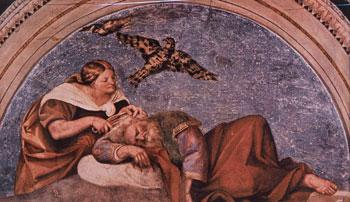
Scylla cutting Nisus' lock, Sebastian del Piombo,
Villa Farnesina, ca. 1512
For example, in this 16th century painting by Sebastian del Piombo of the ancient Greek tale of Scylla, the daughter of King Nisus tries to win the love of his enemy, King Minos, by cutting off her father’s famous purple lock of hair, the secret of his power. To her chagrin, Minos rejects her offering and she is eventually transformed into a bird to prevent her intended suicide.
To get back to our story, Delilah’s similar act of betrayal is not for love, but for money. Her mercenary character is further articulated by contrast with Samson’s first wife, who had also been solicited by Philistines, but her they threatened with death. While both betray Samson, Delilah comes off the worse. Artists portray her as a beautiful femme fatale, but not a word is said about her looks.
Likewise, except for being unshorn, in accordance with his nazirite status, there is no description of Samson. But since he performs acts of physical strength, artists have often portrayed him as being muscular.
One of the most famous portrayals of Samson’s downfall is Rubens’ painting of 1609.
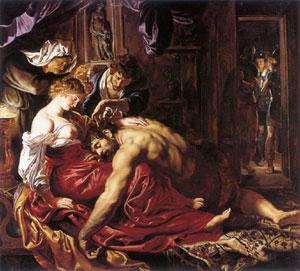
The musclebound Samson is dead center of a crowded room, his left arm limply falling to the floor, like a defeated wrestler. Delilah is a luscious whore, attended by her procuress and a barber, who make the scene disturbingly voyeuristic, while the Philistines wait in the shadows. A strong diagonal from upper left to the bare leg in the lower right separates the brazen action from the veiled conspiracy. Thus although Delilah enables Samson’s defeat, she is not the real perpetrator, but merely the lure in a complex plot.
Two nearly contemporary 15th century treatments of the scene portray the couple alone in secluded nature.
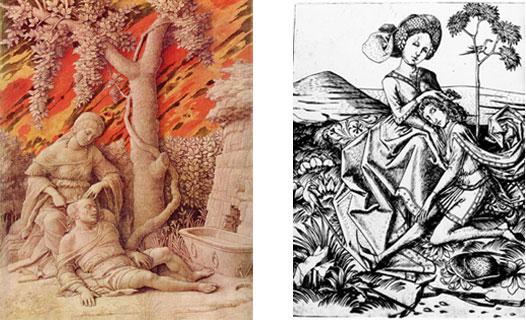
Mantegna’s oil seems to be three dimensional. It has strange overtones of the Garden of Eden and the Pieta. A serpentine vine winds around the thick trunk of a tree, whose only foliage is heavy clusters of grapes. Delilah, cutting the hair of the sleeping Samson, looks serene and benign; she is seated above Samson in a manner echoing the Virgin cradling the dead Jesus in the Pieta. Tension between apparent benevolence and hidden malevolence is palpable in the fiery background contrasting with the monochrome of the foreground and in the obscure inscription cut into the tree, which says that “a bad woman is three times worse than the Devil”.
A German artist known only as “the Master E.S.” portrays the same scene with some strange variations. Samson is a diminutive adolescent, sprouting his first mustache. The much larger Delilah pretends to be guarding the sleeping boy, while in fact she herself is cutting his locks. Like Mantegna’s treatment but in reverse, the bare background contrasts with the frenetic foreground. Thus these 15th century Delilah’s, in extreme contrast to Rubens’, are not overt wantons, but deceptive older women exploiting the naïve “hero”.
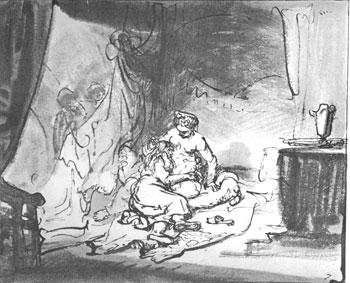
Rembrandt, Samson and Delilah, ca. 1640
In Rembrandt’s drawing, the seduction of Samson is highlighted at center, with the shadowy presence of the Philistines, at left, beyond the curtain. Despite Delilah’s darkened face and her right hand holding the scissors, there is an air of compassion conveyed mainly by Samson’s relaxed embrace, his head nestled against Delilah’s breast. Unlike Rubens’ treatment, which also shows onlookers and is set indoors, Rembrandt’s drawing is not “pornographic”. This Delilah is shrewd, this Samson is pitiable. The composition of the drawing is parallel to Rembrandt’s oil of the same period, which depicts the direct continuation of the plot, in which the Philistines blind Samson.
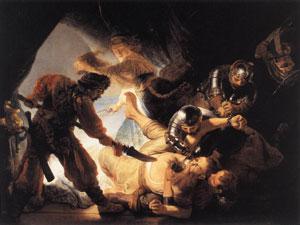
Samson’s flailing leg in the very center of the painting shocks us into attention; the light, entering the tent reveals the hero’s supine bulk, held from above and below by his captors, who are in the act of blinding him. From his grimace, a line leads to a silhouetted spear. Receding into the dark, additional soldiers stand, fearing the hero’s recovery. Delilah, while no longer present in the biblical narrative, is placed by Rembrandt, triumphantly exiting the scene. She holds aloft the magic locks and a pair of scissors, and looks back in wide-eyed wonder, the mirror image of the now blind, defeated Samson. Delilah, like the painting itself, shows no pity, but only cruel amazement at Samson’s fall.
Modern renditions
Moderns have continued to be fascinated by the story of Samson and Delilah, reading it through the prism of a variety of cultural influences.
American Christian artist Kirk Richards, concerned with mythic icons, sits Delilah for her portrait after her betrayal of Samson.
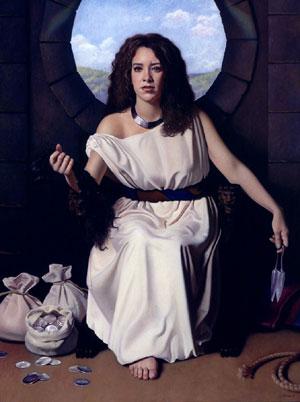
Framed against an incomplete circular window that suggests a fractured halo, she is dressed in pure, luminous white and displays the evidence of her perfidy – scissors and hair. At her feet is her entrepreneurial reward and the rope that could not contain Samson, perhaps hinting at Judas Iscariot’s payment and suicide. This photographic portrayal leaves no room for alternative readings – Delilah is a crass, calculating and unrepentant figure.
In a self-styled Midrash, Nikos Stavroulakis links the story of Samson and Delilah to a verse from Proverbs:
Thoughtlessly he follows her,
Like an ox going to the slaughter,
Like a fool to the stocks for punishment Proverbs 7:22

From Proverbs: Twelve Woodcuts, by Nikos Stavroulakis, 1979
This linkage of remote texts is a classic technique of Midrashic openings, here amplified by translation into the visual. The wider context of the verse from Proverbs clarifies that the scene is a young man being seduced by a lascivious, married woman. According to this reading, Samson is the naif and Delilah is the experienced wanton, who having concluded her session, turns to us with a wink.
An astonishing transformation of the story of Samson and Delilah occurs in the painting and relief of Erte (Romain de Tyrtov).
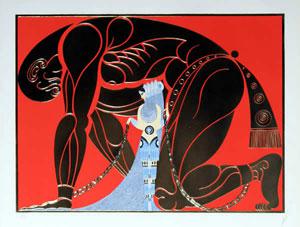
A gigantic Samson, black and animal-like, crouches over the diminutive figure of Delilah, dressed exotically in blue. Next, we notice that she is daintily holding chains attached to the beast’s wrist and ankle. Who’s in charge - Beauty or the Beast? What was Erte's inspiration for such a disproportionate representation of the lovers? We learn that starting in 1925, Erte created Hollywood sets and costumes– could he have read Samson and Delilah in light of the 1932 film classic, King Kong, in which the Beast is subdued because of the beauty of Anne Darrow, as played by Fay Wray?
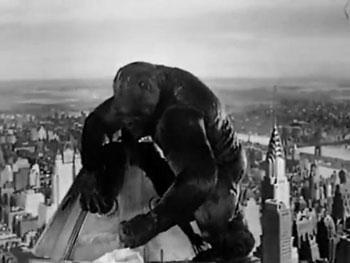
The motif of bondage, so prominent in the biblical tale of Samson and Delilah, is reflected first when Anne is tied up as a sacrifice to Kong.
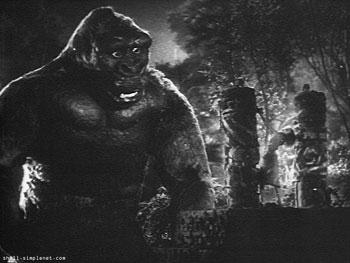
But the roles are reversed and Kong becomes the captive.
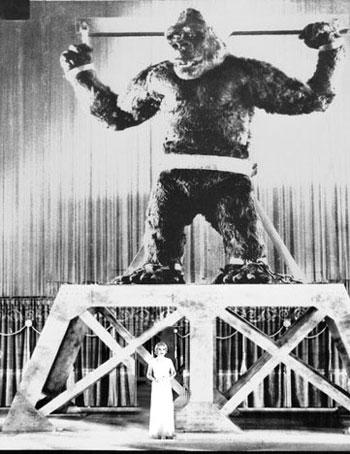
According to this analysis, Erte reads Delilah not in a moralistic manner, but as an example of the Beauty who, intentionally or not, brings the Beast to his knees.
In summation, Delilah’s character amongst artists, expressed purely visually, range from the shameless whore to the wily older woman to the amoral entrepreneur to the guileless beauty – all of these readings are enabled by the Bible’s minimalist description.
From Achsah the businesswoman, to Deborah the strategist, to Yael the assassin, to the self-assured Manoah’s wife and finally to Delilah the arch-femme fatale – one major aspect of the Book of Judges is assertive, dominant women, who assume these untraditional roles because of the absence of male responsibility, endemic to the period. In attempting to relate to these unusual figures, artists have melded these biblical women with models of their own times.
For additional images on this subject see TALI Visual Midrash



